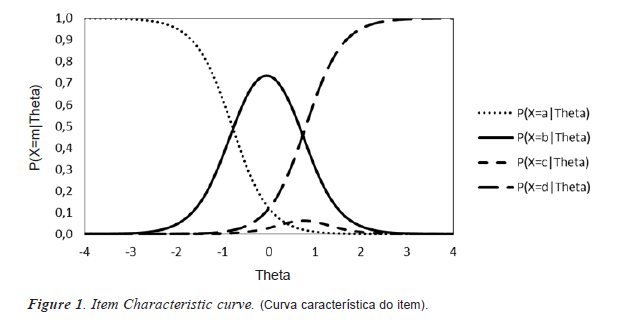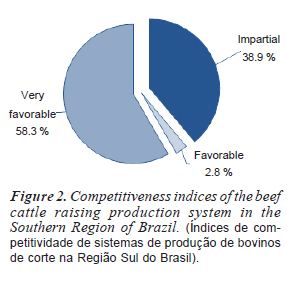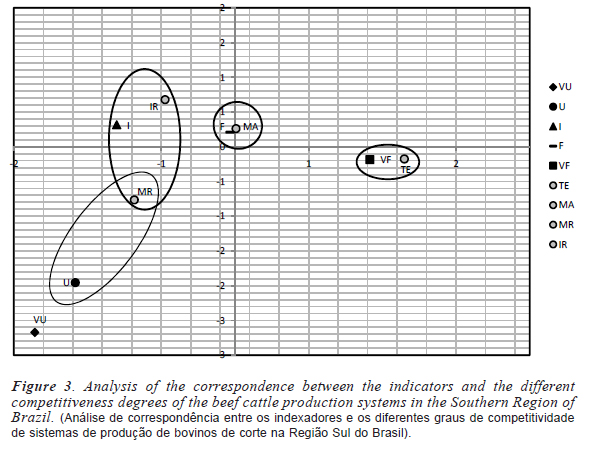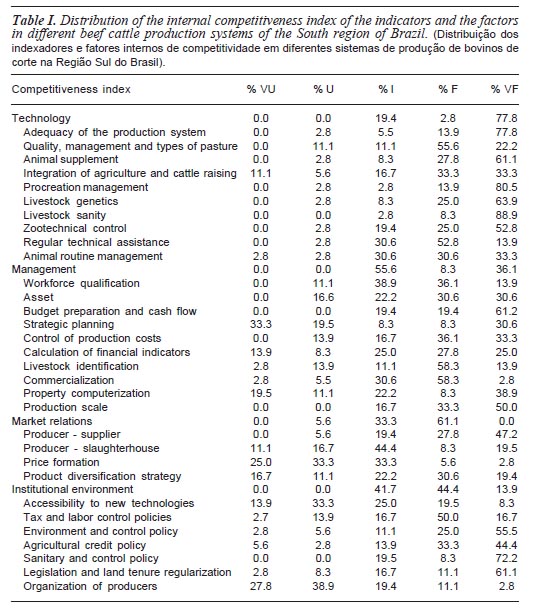Mi SciELO
Servicios Personalizados
Revista
Articulo
Indicadores
-
 Citado por SciELO
Citado por SciELO -
 Accesos
Accesos
Links relacionados
-
 Citado por Google
Citado por Google -
 Similares en
SciELO
Similares en
SciELO -
 Similares en Google
Similares en Google
Compartir
Archivos de Zootecnia
versión On-line ISSN 1885-4494versión impresa ISSN 0004-0592
Arch. zootec. vol.62 no.238 Córdoba jun. 2013
https://dx.doi.org/10.4321/S0004-05922013000200001
Beef cattle production system competitiveness in the south of Brazil
Competitividade de sistemas de produção de bovinocultura de corte na região sul do Brasil
Oaigen, R.P.1*; Barcellos, J.O.J.2; Soares, J.C.R.3A; Lampert, V.N.3B; Gottschall, C.S.4; Marques, P.R.3C and Tavares, H.R.5
1School of Veterinary Medicine. Federal University of Pará (UFPA). Castanhal-PA. *oaigen@ufpa.br
2Department of Zootechnics. School of Agronomy. Federal University of Rio Grande do Sul (UFRGS). Porto Alegre-RS. Brasil. julio.barcellos@ufrgs.br
3Federal University of Rio Grande do Sul (UFRGS). Porto Alegre-RS. Brasil. Asoaresjean@hotmail.com; Bvinlampert@bol.com.br; Crochamarques@hotmail.com
4School of Veterinary Medicine. ULBRA. Canoas. Brasil. carlosgott@cpovo.net
5Institute of Exact and Natural Sciences (UFPA). Belém-PA. Brasil. heliton@ufpa.br
SUMMARY
The internal competitiveness of the beef cattle production systems in the Southern Region of Brazil was studied. Thirty-six beef cattle farmers of the state of Rio Grande do Sul were interviewed during the first quarter of 2010. The main indicators that affect the farm gate sector competitiveness were defined: technology, management, market relations, and institutional environment. Then, those indicators were developed into 10, 10, 4 and 7 factors respectively. They were assigned individual weights in order to calculate their competitiveness indices (CI) with specific equations. The competitiveness indices for the 4 indicators and the 31 factors were also calculated, and they ranged from unfavorable to very favorable. The Item Response Theory was employed to statistically treat the data. Data analysis also employed the Correspondence Analysis Technique (ANACOR) available in the SPSS software in its 18.0 version. The average CI of the production systems 7.27, which is considered a favorable one. The main critical competitiveness factors include the producers' organization, price formation, strategic planning and availability of technological innovations. Researches like the current one are of fundamental importance to develop strategies to be carried out by both the public and the private sectors aiming to enhance competitiveness of the beef production chain.
Key words: Agribusiness. Management. Production chain.
RESUMO
Objetivou-se mensurar a competitividade interna dos sistemas de produção que atuam na bovinocultura de corte na Região Sul do Brasil. Foram realizadas entrevistas durante o primeiro trimestre de 2010 com 36 pecuaristas que atuam na bovinocultura de corte no Estado do Rio Grande do Sul. Foram definidos os principais direcionadores que afetam a competitividade dentro da porteira, sendo estes a tecnologia, a gestão, as relações de mercado e o ambiente institucional. Posteriormente estes foram desdobrados em dez, dez, quatro e sete fatores, respectivamente, sendo atribuídos pesos específicos para cada um deles a fim de determinar o índice de competitividade (IC) por meio de equações específicas. Foi calculado também o grau de competitividade dos quatro direcionadores e dos 31 fatores, variando de muito desfavorável a muito favorável. Os resultados foram analisados estatisticamente pela teoria de resposta ao item e pela análise de correspondência através do software SPSS. Os sistemas de produção apresentaram, em média, um IC favorável (7,27). Entre os principais fatores críticos de competitividade destacaram-se a organização dos produtores, formação de preços, planejamento estratégico e o acesso a inovações tecnológicas. Estes trabalhos são fundamentais para identificar as ações prioritárias a ser realizadas pelos órgãos públicos, privados e de fomento para alcançar maior competitividade a cadeia produtiva da carne bovina.
Palavras chave: Agronegócio. Cadeia produtiva. Gestão.
Introduction
The market globalization process has imposed major changes on the world economy and, therefore, on agribusiness also. Free market competition has promoted fiercer competitiveness among companies and sectors internally and, especially, externally. This new economic context has posed challenges to the whole agribusiness sector worldwide. According to Saab et al. (2009), competitiveness is achieved when the demands of the different world markets are met by being economically efficient while catering for a general desire for environmental preservation and for social sustainability of all those who directly and indirectly are part of the production processes.
Nevertheless, major problems have prevented a faster development of the beef cattle production sector both nationally and internationally. A diagnostic study on the Brazilian beef cattle production sector carried out in 2000 (IEL/CNA/SEBRAE, 2000) showed that many issues still need to be tackled as to improve the levels of competitiveness in the sector. Besides pointing out the limitations of each examined linkage of the production chain, this study also highlighted that all the agents of the chain have to consider and cater for the consumers' needs, and search for both qualitative and quantitative profits.
A similar study in the State of Rio Grande do Sul, (SEBRAE/SENAR/FARSUL, 2005) reported that beef cattle, formerly the most important economic activity of the state, currently undergoes a troublesome situation marked by low remuneration of capital and land use in analogy to other activities. Thus, the beef livestock of Rio Grande do Sul has lost importance in the national context. This fact is an evidence of difficulties the beef cattle producers of the state have to deal with as consequence of the unfair competition from the Midwestern and Northern regions of Brazil, low prices, adverse weather conditions that cause production and, thus, productivity losses, and lack of policies for the sector. Because of such difficulties, to recover their previous economic position within the national context, southern beef cattle farmers have looked for alternatives: as to export meet to countries which cattle farmers of the other Brazilian states were not qualified to do business with, due to the adequate sanitary conditions of Rio Grande do Sul.
According to Kupfer and Hasenclever (2002), there are business structural systemic factors that go beyond the limits of a single firm affecting and directly determining competitiveness. Hence, those factors affect a firm's capacity of developing and implementing strategies to increase competitiveness. Di Serio and Vasconcellos (2008) report the need for a strategic plan within the internal structure of a firm. This plan needs to address three factors: management (business strategies, operational strategies and a management focus); technology (product, process and information); and personnel (qualification, leadership, knowledge, learning and culture).
Van Duren et al. (1991) maintain that at the conceptual level market participation and profitability rates of either a single firm or the whole production chain are important tools to assess competitiveness. In all agribusiness systems and in the beef cattle production one likewise, competitiveness concerns four dimensions: those controlled by the firm itself, those controlled by the government, the quasi-controlled ones, and, finally, the non-controlled ones. Therefore, the rural entrepreneur has to act on the first of these dimensions in order to envisage actions to be carried out in coordination with the other agents of the production chain.
The justification for the present study is twofold. First, the need for the development of a study to assess the competitiveness indices of the farm gate sector of beef cattle production justifies itself in view of the importance of the sector within the beef production chain nationwide, and of the acknowledgement that the sector displays major hindrances that demand diagnosis and adjustment. Second, while keeping a holistic view of the issue, a specific diagnosis obtained through a method aimed at assessing the internal competitiveness of the production systems might foster the development of the studied production chain by helping devise actions to overcome the identified hindrances.
Materials and methods
In the first stage of the present study we used an interview script with 36 beef cattle producers in the State of Rio Grande do Sul during the first quarter of 2010. The methodological design of the study sprang from a combination of procedures previously employed by researchers into diagnosis and conceptual models of agribusiness production chains (Van Duren et al., 1991; IEL/ CNA/SEBRAE, 2000; Batalha, 2007; FAMATO/FABOV, 2007). However, this research focused only on the farm gate sector of beef cattle production chain, especially, on beef cattle producers and their production systems.
Due to the lack of an effective method of internal diagnosis of competitiveness in cattle production systems, we favored a single focus research in order to produce an in-depth analysis of a segment of the beef cattle production chain. The great range of objectives of the studies into agri-food production chains as well as the multiplicity of issues involved in those studies such as the ones related to physical, financial and human resources are barriers impeding a general recommendation of research methodological procedures in the area. The current study was designed under the assumption that if the main objective of a research project is to search for intervention measures to improve the performance of the investigated production chain, it is more desirable to give up statistics accuracy of data in favor of advantages such as cost and quickness. Therefore, it employed the rapid assessment method since it is a framework that combines data collecting procedures and statistical flexibility.
The questionnaire used was elaborated by a multidisciplinar team of experts from fields such as Agronomy, Zootechnics, Veterinary Medicine, Agribusiness, Economics, Accounting and Management. This multidisciplinar team resorted to their academic and technical expertise to define the major indicators of competitiveness for the farm gate sector of beef cattle production. They are: technology (TE), management (MA), market relations (MR), and institutional environment (IE).
These indicators were developed into 31 factors which were then analyzed in order to measure the magnitude of their contribution to the efficiency of those indicators. TE, MA, MR and IR indicators comprised ten, ten, four and seven factors respectively. The multidisciplinar team assigned a specific weight to each factor and each indicator to determine the competitive index (CI).
On the basis of the information obtained in the interviews and in the preliminary research with the team of experts, each factor was assigned a weight. The questionnaire consisted of four questions on each factor. The responses to these questions could be either positive or negative. The more the positive responses, the higher the degree of competitiveness of the factor, the respective indicator and, consequently, the CI of each production system. Different weights were assigned to each factor on account of the degree of their relevance to the indicator. With such procedure, the final measurement of the indicators was calculated through formula 1.
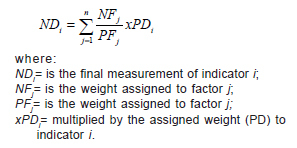
The scores of the factors (NFj) were obtained on basis of the participants' responses (formula 2). The percentage of accuracy (PAj) of each response and the weight assigned to each factor (PFj) determine the factor score.

The number of positive responses determined the evaluation of the factors. The Likert Scale was employed in the evaluation (Trochim, 2002). The criterion used to qualify the responses and determine the percentage of accuracy follows: VF - Very favorable: 04 (four) positive responses (100 %); F - Favorable: 03 (three) positive responses (75 %); I - Impartial: 02 (two) positive responses (50 %); U - Unfavorable: 01 (0ne) positive response (25 %); VU - Very unfavorable: no positive response (0 %).
A new formula was developed (formula 3) in order to calculate the internal competitiveness index of each production system. The competitiveness index (CI) comprises scores and weights assigned to the studied competitiveness indicators and factors. It is obtained by adding up the indicators scores. Afterwards, the arithmetic mean of all the systems was calculated.

In defining the index competitiveness (formula 3), the weights of the indicators were the following: technology (3.5); management (3.5); market relations (2.0), and institutional environment (1.0). Those indicators more closely dependent on the beef cattle farmers' entrepreneurial attitudes and actions received higher weights. The classification of the CI was based on the following criterion: VF: score > 8.0; F: 6.0 <= score ≤= 8.0; I: 4.0 < score ≤= 6.0; U: 2.0 < score ≤= 4.0; VU: score ≤= 2.0.
The Item Response Theory (IRT) - widely used in education, social, human and health sciences - was employed to statistically treat the data. The utmost advantage of using IRT is that its analysis focuses on the items rather than on the assessment as a whole. Therefore, it is appropriate to be used in researches which compare different populations undergoing the same type of assessment, and in those that study the same population undergoing different assessments (Andrade et al., 2000).
According to Andrade et al. (2000), the Item Response Theory (IRT) is a set of probabilistic models used by researchers in various areas (Psychometrics, Marketing, Educational Assessment, Genetics, among others) to evaluate the behavior of the responses of individuals to a set of items with two or more categories. Although the popularity of IRT models have been applied and presented more often work in the area of psychology and education, various applications of these models have provided very important and significant results in other fields of science.
The IRT is a set of statistical models that seek to represent the probability of a search or to receive a specific response to a particular item, as a function of the parameters of the item and the score of the respondent. This probability is calculated by the expression:

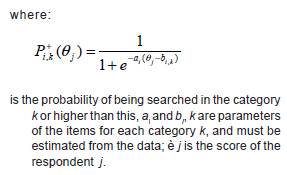
We can plot the probability Pi, k (θj) (figure 1).
The bi,k is the parameter location of category k of item i, estimated on the same scale è j, representing the importance of the i-ésimo item to estimate the score, ai is the discrimination parameter (or slope) of item i, representing the contribution of the i-ésimo item to discriminate between respondents with low and high grade. The estimation of parameters of the items and scores from the TRI data is made by the Method of Marginal Maximum Likelihood (Andradeet al., 2000).
Data analysis also employed the Correspondence Analysis Technique (ANACOR) available in the SPSS software in its 18.0 version. For Mangabeira et al. (2002), analysis produced through the ANACOR technique provides information to portray the production systems by describing all the possible relations between the participants' responses - beef cattle farmers in the current study - and the selected variables. The objective of the ANACOR analysis is to produce the typology of the individuals. It is so done on basis of the notion of similarity, that is, two individuals are considered similar when they display a number of common traits. The first step of this technique is to apply the Chi-square test in order to assess the degree of dependence of the observations. In general, the p-value of such variable dependence is close to zero, that is, p<0.05.
Results and discussion
The production systems studied herein can be considered as big estates since 86.1 % of them are over 900 ha. The main economical activities developed in those estates were beef cattle raising in association with rice and or soybean cultivation. This integration system was present in 31 studied estates.
Seventy % of the cattle farmers in the study hold a college degree. Most of them work exclusively in the rural estate. The greater integration with the agriculture in the region should be characterized as an important factor in local competitiveness, since it provides the maximization of resource use for increased productivity and profitability of production systems. In addition, features a profile of the entrepreneur and entrepreneurial farmer who brings positive consequences to access innovative production technologies and use of management tools that maximize the use of factors of production (land, capital and labor).
The average CI of the investigated estates in the Southern Region of Brazil was 7.27, which is considered a favorable one. Figure 2 displays the production systems classified according to their competitiveness degrees. 61.1 % of the estates displayed either VF or F competitiveness indices on account of the high scores of the technological (7.88) and the managerial (6.65) indicators as well as their high weight in the CI. No production system displayed U or VU competitiveness indices. As mentioned elsewhere, measurement of the internal competitiveness of the beef cattle production systems is fundamental in order to identify the barriers to their efficiency, be them internal or external to the rural business companies.
In accordance with Callado and Moraes Filho (2008), competitiveness in agribusiness can be understood as the sustainable capacity of an enterprise to survive and even to expand by competing in the existing markets, and by conquering new ones through a system of information that cater for management long term planning demands. In the agribusiness sector, competitiveness as a consequence of globalization exhibits three capacity levels: productive and technological, innovation, and coordination.
The correspondence of indicator analysis (figure 3) revealed a strong association between the technology and the management factors, which are internal to the firm, with VF and F competitiveness indices, respectively. In contrast, the external factors - market relations and institutional environment - showed association with I competitiveness index. Being external to the firm and of low controllability, it is difficult for the rural entrepreneur to act on the latter ones.
The described situation demonstrates the difficulty in structuring and organizing the beef production chain, which is a consequence of poor agreement and integration of its linkages - input suppliers, farmers, meat processing industry and meat retailing. According to Saab et al. (2009), the beef production chain displays less coordination if compared to pork and poultry industries. What is more, it is still characterized by producers and slaughterhouse owners who seek quick profits. In this sense, coordinating the linkages of the production chain by doing business via contracts, establishing marketing alliances and business partnerships, among other actions, are of fundamental importance in the pursuit of efficiency of agribusiness systems.
A similar study analyzing the competitiveness of the beef cattle production chain in Mato Grosso State, FAMATO/FABOV (2007) identified low competitiveness indices for virtually all the indicators in the farm gate sector. The indices ranged from impartial to very unfavorable. The beef production chain structure and the market relations stood out among the worst indicators. The former received the lowest scores on logistics and the poor quality of the roads, while the latter on the relationships between the producers and slaughterhouses. The management of the production system indicator also had a very poor performance, especially regarding the control of production costs.
Malafaia et al. (2009) add that the historical conflicts existing among the different beef production chain agents have established relationships among its different linkages grounded solely on market relations. The slaughterhouses' predominant concern has been to meet their slaughter demands, which has led the farmers to be wary of such opportunistic behaviors. Concerning the farmer-slaughterhouse relation and price formation indicators (table I), the findings of the current study depict the production linkage (especially the farm gate sector) as the most negatively impacted one due to its low bargain capacity in presence of the linkage that follows it. Such scenario defines the farmers as price takers only.
Table I brings the percentage distribution of the competitiveness indices of the indicators and of the 31 factors used to portray the performance of the internal competitiveness of the beef cattle production systems. The production systems of beef cattle in southern Brazil showed a favorable level of competitiveness, due to greater specialization of activity and entrepreneurship. Aspects technological related to animal production had a level of competitiveness very favorable. But advances are needed, especially in technology management, the use of management tools, in the relations between the productive chain, the organization of producers and access to technological innovations (extension).
The main critical competitiveness factors classified within the management indicator reached the index of 20 % by adding the U and VU criteria of classification. Lack of strategic planning, measurement of the financial indicators and computerization of rural enterprises are stood out factors.
Shortage of management control has been commonly diagnosed in studies on beef production chain (IEL/CNA/SEBRAE, 2000; SEBRAE/SENAR/FARSUL, 2005; FAMATO/FABOV, 2007). Therefore, it is of fundamental importance that farmers as well as those professionals who provide them technical assistance and act on rural extension services develop strategies to enhance competitiveness in the sector. The measurement and analysis of production costs need to be associated with studies on technical and financial indicators. The strategic planning as well as its periodic assessment by means of reports is fundamental in supporting the management process. We, therefore, should bear in mind that those reports might provide managers with the information on the company development, not only in terms of the costs and achieved goals, but also in allowing problems to be more promptly solved.
With regards to the institutional environment indicator, the critical factors of competitiveness were the accessibility to technological innovations and organization of the producers. In considering the first of the mentioned factors, it is seen in part, as a consequence of the cattle producers' lack of interests in the studies generated at the universities and research centers in the South region of Brazil. This condition may bring up some dispute over the effective benefits of the distribution of agricultural technological knowledge. In this sense, studies like the current one seek to identify and signal the main actions and lines of research to be developed by both the public and private institutes that foment researches and rural extension.
The market relation unfavorable between producer - slaughterhouse (table I) is ascribed to the historically conflicting relationships between farmers and slaughterhouses in the state of Rio Grande do Sul (Ferreira and Padula, 2002). The fact that the farmers have less control over the prices paid for their products, and their smaller capacity of aggregating values and differentiating their products can be additionally held responsible for such situation. The observed lack of organization among the producers has been pointed out by 65 % of the interviewees who said this factor to be U and VU. This is a harmful situation for the primary sector because it reduces the farmers' bargain power in negotiations both in the inside farm gate and the outside farm gate linkages of the production chain. In addition, the higher consolidation of some sectors such as the fertilizer industries and meat packing plants (the slaughterhouses) give them some advantages in negotiating with the inside farm gate linkage (production systems).
According to Malafaia and Barcellos (2007), the strategic associations between the linkages of the production chains come up as interesting alternatives seeking for the coordination of its constituent agents. The management of the supplying chain would be a way towards a higher competitiveness as it is evident that the efficiency throughout the chain can be improved by means of sharing information and continuous planning among its several agents. This improved integration should possibly lead its actors to a clearer understanding of its clients' and suppliers' processes and consequently a better synchronization.
Actions at this level are extremely relevant for the beef production chain in the State of Rio Grande do Sul to reach higher competitiveness indices of the sector. Other actions such as the search for better internal efficiency and specialization of the production systems, high enterprise capacity, effective participation in the Brazilian meat exportation sector, penetration in new market niches with the introduction of diversified products, and above anything else, public policies for the support of the sector are essential for the social and economical sustainability of the rural enterprises.
Conclusions
The systems of beef production in the South of Brazil are competitive because the entrepreneurs attitude, mainly in what concerns the employment of production technology and management tools, is satisfactory. Some aspects require improvement, especially those related to the organization, price formation, strategic planning, property computerization and accessibility to technological innovations.
In this sense, steps must be put forward aiming at the correction of the obstacles which impair the production systems efficiency for either the ones under the authority of the rural entrepreneur or the agents or institutions which constitute the beef agro industrial production system.
Studies which focus on the measurement of sector competitiveness in the agribusiness industry are of paramount importance because they identify priorities to be dealt with by the public, private and fomentation agencies connected to the production chains. Further researches are required in order to make specific diagnosis of the different linkages of the beef production system aiming at an improved coordination of their agents.
References
1. Andrade, D.F.; Tavares, H.R. e Valle, R.C. 2000. Teoria da resposta ao item: conceitos e aplicações. SINAPE. Campinas. 164 pp. [ Links ]
2. Batalha, M.O. 2007. Gestão agroindustrial. 3a ed. Atlas. São Paulo. 778 pp. [ Links ]
3. Callado, A.A.C. e Moraes Filho, R. A. 2008. Gestão empresarial no agronegócio. In: Callado, A.A.C. (Org.). Agronegócio. 2a ed. Atlas. São Paulo. pp. 20-29. [ Links ]
4. Di Serio, L.C. e Vasconcellos, M. A. 2008. Estratégia e competitividade empresarial - inovação e criação de valor. Saraiva. São Paulo. 364 pp. [ Links ]
5. FAMATO/FABOV. 2007. Diagnóstico da cadeia produtiva agroindustrial da bovinocultura de corte do Estado do Mato Grosso. Federação da Agricultura e Pecuária do Estado do Mato Grosso. Cuiabá. 522 pp. [ Links ]
6. Ferreira, G.C. e Padula, A.D. 2002. Gerenciamento de cadeias de suprimento: novas formas de organização na cadeia da carne bovina do Rio Grande do Sul. Rev Adm Cont, 6: 167-184. [ Links ]
7. IEL/CNA/SEBRAE. 2000. Estudo sobre a eficiência econômica e competitividade da cadeia agroindustrial da pecuária de corte no Brasil. Instituto Euvaldo Lodi. Brasília. 398 pp. [ Links ]
8. Kupfer, D. e Hasenclever, L. 2002. Economia industrial: fundamentos teóricos e práticas no Brasil. Campus. Rio de Janeiro. 680 pp. [ Links ]
9. Malafaia, G.C. e Barcellos, J.O.J. 2007. Sistemas agroalimentares locais e a visão baseada em recursos: construindo vantagens competitivas para a carne bovina gaúcha. Rev Eco Agro, 5: 25-50. [ Links ]
10. Malafaia, G.C.; Maciel, A.C. e Camargo, M.E. 2009. Atitudes de coordenação de produtores rurais na cadeia da carne bovina: o caso do cite 120. Org Rur Agro, 11: 393-406. [ Links ]
11. Mangabeira, J.A.C.; Romeiro, A.R.; Azevedo, E.C. e Zarioni, M.M.H. 2002. Tipificação de sistemas de produção rural: a abordagem da análise de correspondência múltipla em Machadinho d'Oeste-RO. EMBRAPA. Campinas. (Circular Técnica, 8). 26 pp. [ Links ]
12. Saab, M.S.B.L.M.; Neves, M.F. e Claudio, L.D.G. 2009. O desafio da coordenação e seus impactos sobre a competitividade de cadeias e sistemas agroindustriais. Rev Bras Zootecn, 38: 412-422. [ Links ]
13. SEBRAE/SENAR/ FARSUL. 2005. Diagnóstico de sistemas de produção de bovinos de corte do Estado do Rio Grande do Sul. Serviço Brasileiro de Apoio a Empresas. Porto Alegre. 257 pp. [ Links ]
14. Trochim, W.M. 2002. Likert scaling. <http://trochim.human.cornell.edu/kb/scallik.htm> (10/ 08/2002). [ Links ]
15. Van Duren, E.; Martin, L. and Westgren, R. 1991. Assessing the competitiveness of Canada's agrifood industry. Cana J Agric Econ, 39: 727-738. [ Links ]
Recibido: 5-4-11.
Aceptado: 26-6-12













